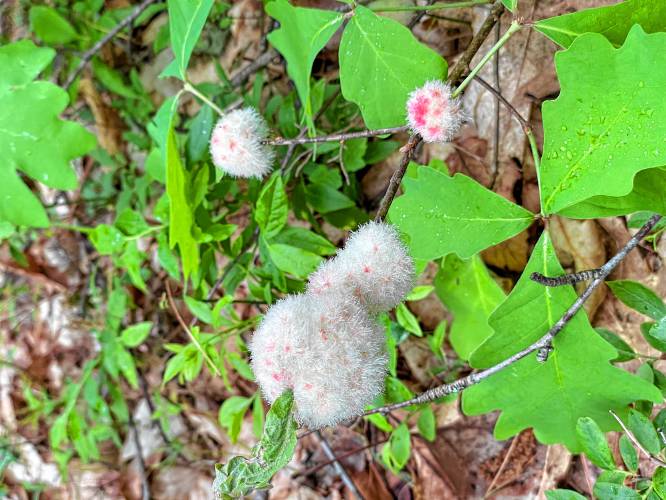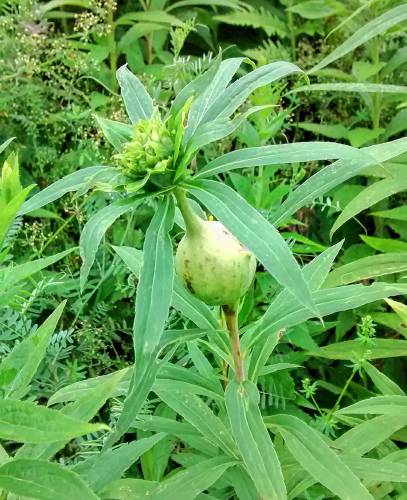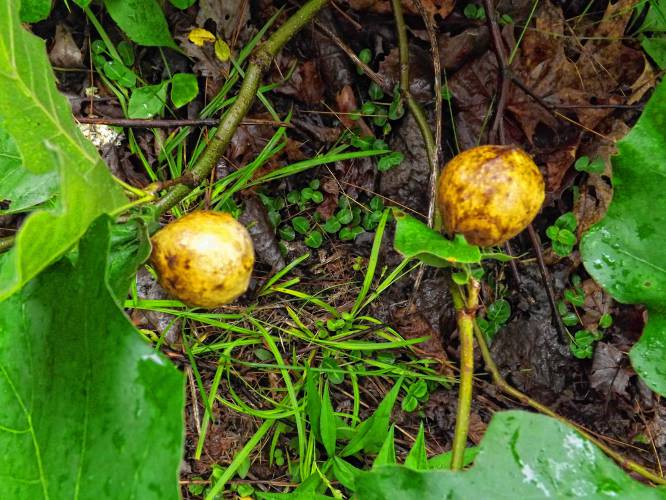Take Me Outside: Golly, it’s a gall
| Published: 06-15-2024 8:01 AM |
A friend sent me a text message recently in which she asked, “Any idea what these are?” An attached photo showed some round, white, pompom-like objects.
I knew the objects were galls but to identify the specific kind, I needed to do a bit of research.
Galls are odd growths found on plants. Sometimes they are papery brown orbs on oak leaves, swollen balls on goldenrod stems, bulging kidney-shaped bumps on blueberry branches, or white woolly pompoms on oak branches. All of these are the result of an interaction between insects and a host plant.
Mites, nematodes, bacteria, fungi or viruses can initiate gall formation, but insects are mostly to blame. When a female insect lays an egg inside plant tissue and the larva emerges from that egg, it secretes a chemical substance that interferes with normal plant growth. The unusual growth that results creates a structure around the larva, isolating it from the rest of the plant, the outside world, and providing a protective nursery in which the larva grows.
Galls are both species and location specific, taking on various shapes, depending on the instigating insect, the species of plant and the location of the disturbance on the host plant.
Some of the most common galls form on oak trees. Of the 2,000 insect species that stimulate gall formation, at least 800 of them use oaks as their host. The photo I received (and is pictured here) is a woolly oak gall, stimulated by the wool sower gall wasp. This small wasp (1/8” long) is harmless to people, only lays eggs on white oak branches (a clue from the photo) and only in the spring (like now). The larva is housed within a tiny hard capsule in the middle of the gall and will remain there for up to three weeks before emerging.
A more commonly seen gall formed by a different type of wasp is the brown, papery oak apple gall. The size of a ping pong ball, it’s found on oak leaves. A tiny hole in the gall will indicate that the wasp larva has pupated, and the adult has moved out, usually in June or July.
Goldenrods also attract many different gall-making insects. In the case of the goldenrod ball gall, a female fly lays her eggs in the stem in late spring or early summer. Ten days later, the larva will hatch and begin eating. The gall forms, grows and provides nutritious food (and protection) for the larva. In the fall the larva becomes dormant and remains so all winter. Pupation occurs in spring and two weeks later the adult emerges to start the process all over again.
Article continues after...
Yesterday's Most Read Articles
 Restaurant owner settles lawsuit against Franklin, but didn’t get what she sought
Restaurant owner settles lawsuit against Franklin, but didn’t get what she sought
 Trump’s order to end homelessness could overwhelm New Hampshire’s mental health system, advocates say
Trump’s order to end homelessness could overwhelm New Hampshire’s mental health system, advocates say
 With Steeplegate still held up in court, city privately debates public investment
With Steeplegate still held up in court, city privately debates public investment
 Former Castro’s building to hold apartments and the cigar shop will return, eventually
Former Castro’s building to hold apartments and the cigar shop will return, eventually
 ‘Peace of mind’: As New Hampshire nixes car inspections, some Concord residents still plan to get them
‘Peace of mind’: As New Hampshire nixes car inspections, some Concord residents still plan to get them
 Education commissioner nominee Caitlin Davis receives unanimous bipartisan support on eve of confirmation vote
Education commissioner nominee Caitlin Davis receives unanimous bipartisan support on eve of confirmation vote
The elliptical stem gall is formed on goldenrod by a moth larva. Eggs are laid in the fall among leaf litter near goldenrod. The larvae emerge in the spring, seek and burrow into the stem of goldenrod plants. This intrusion causes the goldenrod to form a gall, enclosing the larvae. Within the gall the larvae pupate. Emerging adults will mate and lay eggs, completing the cycle.
A different formation, the goldenrod bunch gall is a flower-like growth at the tip of the plant created by a tiny gnat or midge.
Not all galls are single occupancy dwellings. The blueberry stem gall, often seen on wild blueberries, is a kidney-shaped lump and may contain 12 larvae. If there are tiny holes and the gall is brown, the adults probably came out in May or June. If the gall is reddish and whole, this year’s larvae are growing and eating within it. It will reach its full size by late August, the larvae will overwinter, pupate in spring and emerge as adult wasps next year.
Though galls provide protection for larvae from weather and in some case predators, birds such as chickadees and downy woodpeckers commonly peck into these galls to extract protein rich larvae. Parasitic insects may also prey on the gall creators. All these predators help keep the galls from becoming too prolific. Galls rarely cause significant damage to the host plants, so the next time you see an odd growth on a plant, rather than being alarmed about it, ponder the life cycle that may be taking place within its walls.










 Franklin Area Children’s Theatre presents “Dear Edwina Jr.”
Franklin Area Children’s Theatre presents “Dear Edwina Jr.” Bow Rotary holds summer concerts
Bow Rotary holds summer concerts League of NH Craftsmen 92nd annual fair coming to Newbury
League of NH Craftsmen 92nd annual fair coming to Newbury
